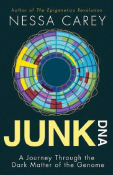BOOKMARK

Title: Junk DNA: A Journey Through the Dark Matter of the Genome
Author: Nessa Carey
Publisher: Columbia University Press
Original publication date: April 2015
Price: $22.95, paperback, 360 pages
When biologists first delved into the human wonder of genes in the 1970s, they eventually discovered small pieces of DNA that coded for proteins that seemed to float aimlessly around the genetic domain. Francis Crick, co-discoverer of DNA’s double-helical structure surmises that it was “little better than junk.” Our genetic blueprint consists of about 3.42 billion nucleotides sandwiched into 23 pairs of linear chromosomes. However, all mammals have massive amounts of DNA that simply doesn’t code for the proteins used to build our bodies. In humans, only a miniscule 2% of our DNA codes for proteins.
The DNA Junkyard
Hence the term “junk protein,” coined in 1972 by the late geneticist Susumu Ohno, which describes all noncoding sections of the genome. Words matter, and although the term “junk DNA” has a certain catchiness, it effectively repelled researchers from studying noncoding DNA for decades. In her meticulously researched book, Junk DNA: A Journey Through the Dark Matter of the Genome, science writer Nessa Carey provides a clearly drawn introduction of junk DNA and its vital connection to such phenomena as genetic diseases, viral infections, sex determination in mammals, and even evolution. This book follows her earlier and highly acclaimed book, The Epigenetics Revolution: How Modern Biology Is Rewriting Our Understanding of Genetics, Disease, and Inheritance.
Ms. Carey comes well equipped to tackle the task of explicating a confounding scientific area of genetics. Having earned her PhD in virology from the University of Edinburgh, she worked in the biotech industry for more than a decade, cultivating relationships with leading researchers in Europe and across the United States at institutions such as Harvard Medical School and MD Anderson Cancer Center.
Despite her solid science writing background, Ms. Carey’s targeting a tough reading population: smart lay people who love challenging science writing and those in the medical and science fields, and both readers will open the book with expectations.
Putting a Face on DNA
Ms. Carey smartly introduces her book with a snappy primer on DNA and “junk DNA,” pointing out that researchers are only just beginning to unravel the subtleties and interconnections in the vast genetic networks. Although many book introductions receive just a cursory glance, this one is worthy of a solid read, as Ms. Carey establishes her smart but conversational narrative voice and titillates the reader with intrigue—a mystery of sorts awaits in the land of dark matter.
What’s the best way to grab a reader’s attention? Put a face on the science. She opens Junk DNA, “Sometimes life seems to be cruel in the troubles it piles onto a family. Consider this example. A baby boy is born named Daniel. He was strangely floppy at birth and had trouble breathing unassisted. With intensive medical care Daniel survived and his muscle tone improved, allowing him to breathe unaided and to develop mobility. But as he grew older it became apparent that Daniel had pronounced learning disabilities that would hold him back throughout his life.” Daniel’s heart-wrenching plight becomes the jumping point to why dark matter matters.
The book is organized in 20 concise chapters. And each of the chapters has up to 40 classic and current literature references as well as well-designed figures and charts to elucidate the hypotheses in this hotly disputed field.
There is a huge amount of scientific data and research to cover, and, for the most part, Ms. Carey does a good job; most biochemical concepts come across well. The hard chemistry is also deftly simplified, which is no easy task. For example, she describes DNA methylation as, “A chemical group called methyl can be added to the C…just one carbon atom and three hydrogen atoms.”
Her editor added to the charm of this highly readable book with enticing chapter titles such as “Everything Shrinks When We Get Old” and “Why Parents Love Junk.” Readers of The ASCO Post will find much to admire in the sections on telomeres and noncoding RNAs. However, the author’s expertise in DNA and junk DNA leads her into difficult territory when she takes the next leap into oncology.
Much to Learn
Ms. Carey is at her best when she sticks to her area of expertise, namely what she’s centered her book on: junk DNA. To that end, perhaps the book’s best chapter is chapter 14 and the fascinating discussion of the 2012 project ENCODE (Encyclopedia of DNA Elements), which gives readers a fly-on-the-wall peak at a good old-fashioned scientific brawl. Using the most sensitive techniques available, researchers probed multiple features of the human genome and broke into two ranks: the first were DNA junk skeptics, the second were evolutionary theorists who embraced “junk.” What follows is a riveting examination of the dark matter in our DNA and the scientists who explore such things.
We are just beginning to unlock the secrets of junk DNA, and like any exploration into the unknown, there are missteps and unanticipated pleasures. Junk DNA: A Journey Through the Dark Matter of the Genome is a smart, well-written book, full of information, sometimes a bit dense for the lay public, but a winner for those with a science background. This book is recommended for readers of The ASCO Post. ■

